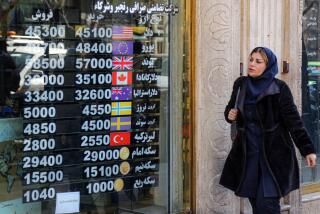Modern Life Intrudes on Nomads
- Share via
DOROUD, Iran — When the warmth of spring begins to set in, the Bakhtiari nomads pack up and head off--women on horseback, men on foot, belongings in tow--for the cooler climes of the Zagros mountains.
In fall, they make the return trip to the warm plains of the southwestern province of Khuzestan, away from the subzero temperatures of the mountains.
“Iran’s vast land is our carpet and the sky is our roof,” says Hossein Hajivand, who with his family retraces the footsteps of his ancestors every year.
“This has been our life for as long as history can remember. Sometimes life becomes intolerable, but we’ve got to migrate all the time,” he says.
It’s a way of life that has endured for thousands of years, though modern pressures are starting to erode the tradition.
The government and developing towns have taken over pasture where Bakhtiari goats or sheep once roamed freely. The nomads are restricted to less fertile lands or pastures in hard-to-reach mountainous regions, places that don’t interest city dwellers.
Occasionally, younger tribesmen turn their backs on the nomadic life to study or seek jobs.
“Modern life, to some extent, has affected Bakhtiari life,” says Aliqoli Mahmoudi Bakhtiari, who gave up life on the move to become a professor of linguistics and Persian literature. But “most of them have such a strong belief in migrant life that they are not ready to give it up for a modern life.”
Hajivand, who cannot read or write, has little use for new ways.
“I feel it would be suffocating to sleep in a house,” he says, speaking in the Bakhtiari dialect of Farsi called Luri.
His family’s home is a large black tent made of tough goat’s hair woven by his wife. She weaves one tent a year, a months-long endeavor.
The furnishings are spartan. Rugs and mats cover the ground. A few blankets and pillows are piled in a corner. There is a goatskin container for liquids, and a few earthen jars and a bag of grain. The tent, black inside and out and smelling of goat, can be packed quickly for transport.
The nomads, traveling in groups of 20 to more than 100, follow an “eel-rah”--tribal road--that winds through pastureland and water sources.
Although the parents are illiterate, the children know the basics of reading and writing thanks to seasonal classes they attend .
The government strongly encourages all Iranians, including nomads, to send their children to school. Young men must know how to read and write for the required two-year national military service that begins at age 18.
The government encroaches in another way that the nomads prefer: It provides families with AK-47 assault rifles to be used against leopards and other predators. A gun is a source of pride in Bakhtiari culture, and almost all the men know how to shoot.
After a move, some of the men seek employment in nearby farmlands as temporary workers and receive flour and grain in payment.
“Partly, we are regularly migrating from one place to another because we have nothing in this world,” Hajivand said.
More to Read
Sign up for Essential California
The most important California stories and recommendations in your inbox every morning.
You may occasionally receive promotional content from the Los Angeles Times.










